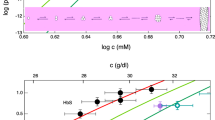Abstract
MOST structural variants of human haemoglobin occur in smaller amounts than HbA in the peripheral blood of heterozygous subjects. Abnormal haemoglobins with mutations in the β chain usually comprise 35–45% of the haemoglobin in haemolysates. In contrast, haemoglobins with abnormal α chains generally amount to only 20–25% of the total haemoglobin. This difference in the proportion of α and β chain variants is thought to reflect the fact that in some populations there are two α loci and only one out of four α globin genes is affected in a heterozygote, whereas one out of two β globin alleles is abnormal in a subject with a β varient1,2. Certain unstable haemoglobins with critical alterations in β-chain structure also constitute a much smaller proportion of the total circulating haemoglobin than HbA. The low concentration of these abnormal haemoglobins is the result of accelerated preferential destruction3–7. We report here a new unstable β variant, Hb Bushwick, which was detected in an intact form constituting only 1–2% of the total circulating haemoglobin. Evidence was found for rapid postsynthetic destruction of the abnormal β chain. In spite of this accelerated loss of the product of one of the two β alleles, the affected erythrocytes contained normal amounts of haemoglobin.
This is a preview of subscription content, access via your institution
Access options
Subscribe to this journal
Receive 51 print issues and online access
$199.00 per year
only $3.90 per issue
Buy this article
- Purchase on Springer Link
- Instant access to full article PDF
Prices may be subject to local taxes which are calculated during checkout
Similar content being viewed by others
References
Lehmann, H., and Carrell, R. W., Br. Med. J., 4, 748–750 (1968).
Hollan, S. R., et al., Nature, 235, 47–50 (1972).
Rieder, R. F., Zinkham, W. H., and Holtzman, N. A., Am. J. Med., 39, 4–20 (1965).
Huehns, E. R., Bull. Soc. Chim. biol., 52, 1131–1146 (1971).
Cohen Solal, M., and Labie, D., Biochim. biophys. Acta, 295, 67–76 (1973).
Rieder, R. F., J. clin. Invest., 50, 388–400 (1971).
Honig, G. R., Mason, R. G., Vida, L. N., and Shamsuddin, M., Blood, 43, 657–664 (1974).
Rieder, R. F., J. clin. Invest., 49, 2369–2376 (1970).
Weatherall, D. J., and Clegg, J. B., The Thalassaemia Syndromes (Blackwell, Oxford, 1972).
Rieder, R. F., and James, G. W., III, J. clin. Invest., 54, 948–956 (1974).
Vernon, L. P., and Kamen, M. D., J. biol. Chem., 211, 643–662 (1954).
Clegg, J. B., Naughton, M. A., and Weatherall, D. J., J. molec. Biol., 19, 91–108 (1966).
Perutz, M. F., Kendrew, J. C., and Watson, H. C., J. molec. Biol., 13, 669–678 (1965).
Dayhoff, M. O., Ed. Atlas of Protein Sequence and Structure, 5 (National Biomedical Research Foundation, Washington, DC, 1972).
White, J. M., Brain, M. C., Lorkin, P. A., Lehmann, H., and Smith, M., Nature, 225, 939–941 (1970).
Sathiapalan, R., and Robinson, M. G., Br. J. Haemat., 15, 579–587 (1968).
Schneider, R. G., Veda, S., Alperin, J. B., Brimhall, B., and Jones, R. T., New Engl. J. Med., 280, 739–745 (1969).
Svensson, B., and Strand, L., Scand. J. Haemat., 4, 241–248 (1967).
Hollender, A., Lorkin, P. A., Lehmann, H., and Svensson, B., Nature, 222, 953–955 (1969)
Honig, G. R., et al., J. clin. Invest., 52, 1746–1755 (1973).
Pedersen, P. R., et al., Blood, 42, 771–781 (1973).
Wajcman, H., Pagnier, J., Labie, D., and Boivin, P., Nouv. Rev. Fr. Hematol., 11, 317–330 (1971).
Luan Eng, L.-I., et al., J. med. Genet., 9, 340–343 (1972).
Kacian, D. L., et al., Proc. natn. Acad. Sci. U.S.A., 70, 1886–1890 (1973).
Fuhr, J., Natta, C., Marks, P. A., and Bank, A., Nature, 224, 1305–1307 (1969).
Conconi, F., and del Senno, L., Ann. N.Y. Acad. Sci., 232, 54–64 (1974).
Author information
Authors and Affiliations
Rights and permissions
About this article
Cite this article
RIEDER, R., WOLF, D., CLEGG, J. et al. Rapid postsynthetic destruction of unstable haemoglobin Bushwick. Nature 254, 725–727 (1975). https://doi.org/10.1038/254725a0
Received:
Accepted:
Issue Date:
DOI: https://doi.org/10.1038/254725a0
This article is cited by
-
Rethinking peptide supply to MHC class I molecules
Nature Reviews Immunology (2007)
-
Molecular basis of ornithine transcarbamylase deficiency lacking enzyme protein
Journal of Inherited Metabolic Disease (1984)
Comments
By submitting a comment you agree to abide by our Terms and Community Guidelines. If you find something abusive or that does not comply with our terms or guidelines please flag it as inappropriate.



